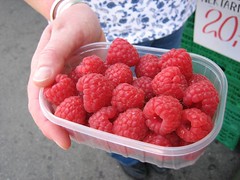More Scandinavian Berries
When we started our trip to Finland and Norway, all we knew about Scandinavian berries was that we wanted some cloudberry liqueur. We began to get an inkling of what else might be available as we walked around the wonderful open-air market in Helsinki. Past all of the crafts and tchotchkes, every day there were many big booths selling all manner of produce, and the tables were piled high with strawberries, raspberries, cloudberries, blackberries, and cherries. We'd come at the right time. We sampled some of the strawberries there, and they were quite lovely, if a bit small.
It wasn't until we reached the open-air market in Bergen, though, that we discovered just how good berries could get in Scandinavia. The basket of raspberries artfully displayed in Kathleen's hand was a revelation. These berries are huge. These are not the thumbnail-sized raspberries of home, these are the size of the whole first knuckle of my thumb, easily twice the heft of what we were used to. And they didn't just look good, they were sweet and flavorful, with just the right touch of tartness that we expect from good raspberries.
Later, on the first excursion from our Norwegian coastal cruise, we took a long bus tour out of Geiranger. Along the way, while waiting for a ferry, the daughters of a farmer were walking among us with big flats of raspberry baskets, and we indulged again, wolfing down all of the nice big beauties before we reached the far side of the fjord.
It turned out that the tour company had a deal with the farmers: each day, they called the farmers to let them know how many buses would be coming through, and when, to let the farmers arrange to be there waiting for us. I don't know what the tour company got out of it, other than the satisfaction of customers like us.
Pursuant to that plan, at a later stop on that tour, there were more daughters of farmers, this time selling baskets of strawberries. Now, the raspberries were enormous, and certainly tasty, but that was nothing as compared to these strawberries. They were of normal size, but truly unbelievable flavor. Oh my god, they were good. So good, that as we worked out way through the basket purchased by a British couple we'd befriended, I swear, every single time somebody started on a new berry, they moaned audibly. They'd forgotten, since the previous berry, just how mind-blowingly marvelous these strawberries were. I could have cried when the last berry was gone. (The daughters, having quickly sold out, were also gone by then.)
Let this be a lesson to you, should you find yourself traveling in midsummer in Norway (and probably Sweden and Finland, too): missing out on the berries is tantamount to missing out on juicy little missives from heaven.
(Oh man, now I really wish I had another basket of those strawberries! This must be how Lucifer felt after the Fall...)
